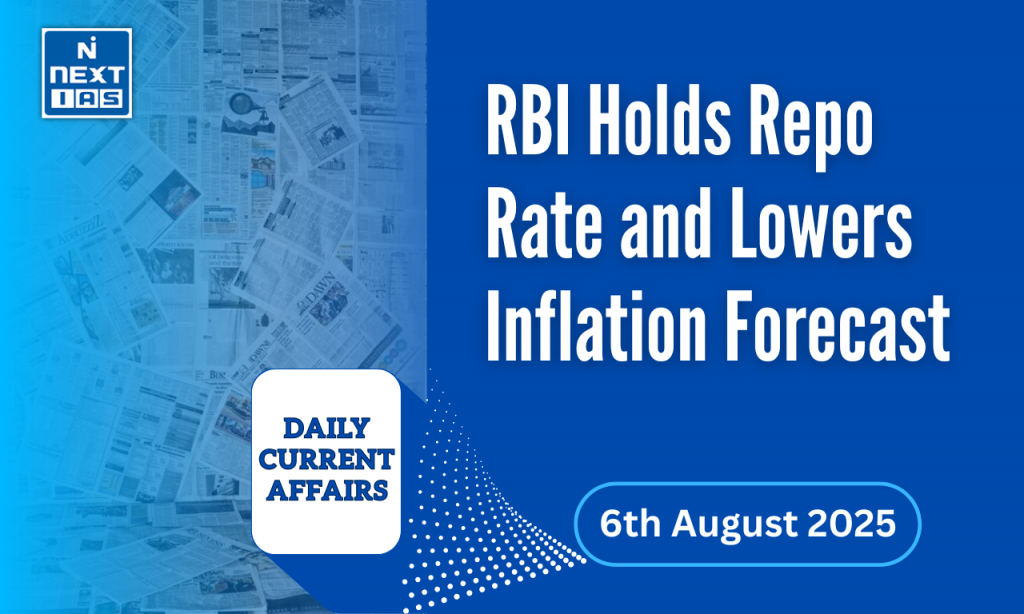
Syllabus: GS3/ Economy
Context
- The Reserve Bank of India’s (RBI) in its Monetary Policy Committee (MPC) meeting decided to keep the repo rate unchanged at 5.50%.
What is the Repo Rate?
- The repo rate is the rate at which the RBI lends short-term money to commercial banks. It is the key policy tool used by the RBI to control liquidity, inflation, and economic growth.
- A lower repo rate means banks can borrow from the RBI at cheaper rates. This encourages banks to lower lending rates, leading to:
- Easier access to credit for consumers and businesses
- Boost in investment, consumption, and economic activity
- Increased liquidity and money supply
- This can stimulate growth, especially during economic slowdowns
What is the Monetary Policy Committee (MPC)?
- The MPC is a statutory body established under the RBI Act, 1934 (amended in 2016).
- It is responsible for fixing the benchmark interest rate (repo rate) to maintain price stability while keeping growth in mind.
- It consists of 6 members:
- 3 from the RBI (including the Governor as Chairperson),
- 3 external members appointed by the Government.
- Decisions are made by majority, and each member has one vote. In case of a tie, the RBI Governor has the casting vote.
Flexible Inflation Targeting Framework (FITF)
- India adopted a Flexible Inflation Targeting Framework (FITF) in 2016. Under this, the government, in consultation with the RBI, sets an inflation target every five years.
- Under this framework, the Government sets the inflation target every five years in consultation with the RBI. The current mandate, effective until March 31, 2026, specifies a CPI inflation target of 4%, with a tolerance band of ±2%, i.e. between 2% and 6%
Reasons Behind the Policy Decisions
- Sharp Decline in Inflation: CPI inflation fell to 2.1% in June 2025, a six-year low.
- Food prices, especially vegetables and cereals, have shown deflationary trends. This led to the downward revision of FY26 inflation forecast to 3.1%.
- Global Uncertainties: Rising trade tensions like US tariffs and volatile oil prices create external risks.
- RBI had already cut the repo rate by 100 basis points earlier in 2025. The committee wants to observe the full impact of these cuts on the economy.
Impact on the Indian Economy
- Impact on Inflation and Prices: The RBI’s revised inflation forecast shows that price levels in the economy are expected to remain stable. This is good for consumers, as the purchasing power of money increases when inflation is low.
- It also helps the government and RBI maintain macroeconomic stability, which is essential for long-term growth.
- Impact on Borrowers and Loans: Since the repo rate remains unchanged, banks are unlikely to change interest rates.
- This means that loan EMIs will stay stable, which is a relief for existing and new borrowers.
- Impact on Economic Growth: By keeping the repo rate steady and supporting low inflation, the RBI is encouraging balanced and sustainable growth.
- Combined with the government’s capital expenditure and infrastructure push, this policy setup will strengthen demand, support job creation, and boost investment.
- Preparedness for External Risks: While the economic outlook is positive, the RBI is being careful due to global uncertainties like oil price volatility, trade tensions, and US tariffs.
- The neutral stance gives RBI flexibility – it can cut rates further if growth slows or raise them if inflation rises unexpectedly.
Way Ahead
- Monitoring Inflation Trends: The RBI must remain vigilant of food and fuel price movements, which are often volatile and can quickly reverse the current softening trend. Unseasonal rains, geopolitical tensions, or supply disruptions can reignite inflationary pressures.
- Structural Reforms and Financial Stability: Alongside monetary tools, India needs to continue structural reforms in agriculture, labour markets, logistics, and financial sectors to ensure long-term inflation control and inclusive growth.
Source: BS
Previous article
Money Laundering